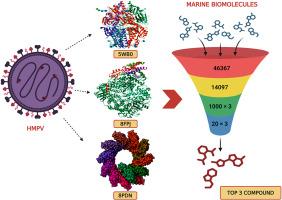Marine bioactive molecules as potential antiviral agents against HMPV key proteins: An integrated machine learning based in-silico approach
IF 3.4
4区 化学
Q2 CHEMISTRY, MULTIDISCIPLINARY
引用次数: 0
Abstract
Human Metapneumo Virus (HMPV), a common respiratory pathogen, is a major health concern, especially for children, elderly, and immunocompromised individuals. Currently there are no approved antivirals or vaccines available for the treatment, this study used an integrated in silico approach to find possible marine-derived inhibitors that target three essential viral proteins, namely, fusion glycoprotein (F protein), RNA-dependent RNA polymerase (RdRp), and nucleoprotein-RNA (N-RNA) complex. After screening a curated library of 46,367 marine products from the CMNPD, 14,097 compounds satisfied drug-likeness standards based on ADME profiling with QikProp. Top candidates CMPD40601 (F protein, docking score: −6.856 kcal/mol), CMPD20129 (RdRp, −5.976 kcal/mol), and CMPD46444 (N-RNA, −6.000 kcal/mol) were found by high-throughput virtual screening (HTVS), which was followed by SP and XP molecular docking. Lys 254 and Asp 336 (F protein), Arg 556 and Lys 19 (RdRp), and Arg 341 (N-RNA) were important interactions. Variable electronic stability was shown by DFT calculations, which showed HOMO-LUMO energy gaps of 5.85 eV (CMPD46444), 5.00 eV (CMPD40601), and 4.79 eV (CMPD20129). Under physiological conditions, these candidates showed robust binding in molecular dynamics simulations (100 ns), with CMPD20129 exhibiting strong residue-level interaction stability. Additional evidence for their suitability as drug leads came from fingerprint analysis and metabolism prediction. These results demonstrate the unrealized potential of marine products in the search for antiviral drugs and suggest that CMPD40601 be considered as a promising lead against HMPV F protein for further preclinical testing.

海洋生物活性分子作为HMPV关键蛋白的潜在抗病毒药物:一种基于集成机器学习的计算机方法
人元肺炎病毒(HMPV)是一种常见的呼吸道病原体,是一个主要的健康问题,特别是对儿童、老年人和免疫功能低下的个体。目前还没有批准的抗病毒药物或疫苗可用于治疗,本研究使用集成硅方法寻找可能的海洋来源抑制剂,靶向三种基本病毒蛋白,即融合糖蛋白(F蛋白),RNA依赖性RNA聚合酶(RdRp)和核蛋白-RNA (N-RNA)复合物。在对CMNPD的46,367种海洋产品进行筛选后,基于QikProp的ADME分析,14,097种化合物满足药物相似标准。通过高通量虚拟筛选(HTVS)筛选到CMPD40601 (F蛋白,对接得分为−6.856 kcal/mol)、CMPD20129 (RdRp,对接得分为−5.976 kcal/mol)和CMPD46444 (N-RNA,对接得分为−6.000 kcal/mol),然后进行SP和XP分子对接。Lys 254与Asp 336 (F蛋白)、Arg 556与Lys 19 (RdRp)、Arg 341 (N-RNA)是重要的相互作用。DFT计算表明,HOMO-LUMO的能隙分别为5.85 eV (CMPD46444)、5.00 eV (CMPD40601)和4.79 eV (CMPD20129)。在生理条件下,这些候选物在分子动力学模拟(100 ns)中表现出强大的结合,与CMPD20129表现出很强的残留水平相互作用稳定性。指纹分析和代谢预测也证明了它们作为药物先导物的适用性。这些结果表明,海洋产品在寻找抗病毒药物方面的潜力尚未实现,并建议将CMPD40601视为抗HMPV F蛋白的有希望的先导物,进行进一步的临床前测试。
本文章由计算机程序翻译,如有差异,请以英文原文为准。
求助全文
约1分钟内获得全文
求助全文
来源期刊
CiteScore
3.50
自引率
7.70%
发文量
492
审稿时长
3-8 weeks
期刊介绍:
The Journal of the Indian Chemical Society publishes original, fundamental, theorical, experimental research work of highest quality in all areas of chemistry, biochemistry, medicinal chemistry, electrochemistry, agrochemistry, chemical engineering and technology, food chemistry, environmental chemistry, etc.

 求助内容:
求助内容: 应助结果提醒方式:
应助结果提醒方式:


